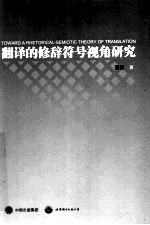图书介绍
翻译的修辞符号视角研究 英文版PDF|Epub|txt|kindle电子书版本网盘下载

- 曹磊著 著
- 出版社: 北京;西安:世界图书出版公司出版社
- ISBN:9787510053610
- 出版时间:2013
- 标注页数:234页
- 文件大小:31MB
- 文件页数:257页
- 主题词:翻译-研究-英文
PDF下载
下载说明
翻译的修辞符号视角研究 英文版PDF格式电子书版下载
下载的文件为RAR压缩包。需要使用解压软件进行解压得到PDF格式图书。建议使用BT下载工具Free Download Manager进行下载,简称FDM(免费,没有广告,支持多平台)。本站资源全部打包为BT种子。所以需要使用专业的BT下载软件进行下载。如BitComet qBittorrent uTorrent等BT下载工具。迅雷目前由于本站不是热门资源。不推荐使用!后期资源热门了。安装了迅雷也可以迅雷进行下载!
(文件页数 要大于 标注页数,上中下等多册电子书除外)
注意:本站所有压缩包均有解压码: 点击下载压缩包解压工具
图书目录
Chapter 1 Introduction1
1.1 Origin and Rationale for the Present Study1
1.2 Definitions of Key Terms10
1.3 Objectives of the Research12
1.4 Methodology14
1.5 Organization of the Dissertation16
Chapter 2 Literature Review19
2.1 About Translation Studies19
2.1.1 Definition and Development of Translation Studies19
2.1.2 Integrated and Interdisciplinary Approaches to Translation Studies21
2.1.2.1 Integrated Approaches to Translation Studies22
2.1.2.2 Interdisciplinary Approaches to Translation Studies24
2.1.3 Non-Western Traditions in Translation Studies28
2.1.4 New Trends31
2.2 Issues and Debates in Translation Studies31
2.2.1 Equivalence31
2.2.1.1 Nida's Concept of Formal Equivalence31
2.2.1.2 Nida's Concept of Dynamic Equivalence33
2.2.1.3 Other Concepts of Equivalence36
2.2.1.4 Summary39
2.2.2 Context in Translating39
2.2.2.1 Register Analysis41
2.2.2.2 Context and Translation44
2.2.2.3 Summary46
2.2.3 The Translator's Role47
2.2.3.1 The Translating Process48
2.2.3.2 Translatability and Untranslatability49
2.2.3.3 Foreignization and Domestication50
2.2.3.4 Summary51
Chapter 3 Toward a Rhetorical-Semiotic Approach in Translation Studies53
3.1 Key Concepts in Semiotics54
3.1.1 The Meaning of Signs56
3.1.2 Semiotics58
3.1.2.1 De Saussure's Sign System61
3.1.2.2 Peircean Signification System63
3.1.2.3 Roland Barthes'Notion67
3.1.3 Semiotic Science68
3.1.3.1 Logical Semiotics68
3.1.3.2 Linguistics as a Branch of Semiotics69
3.1.3.3 Syntax,Semantics and Pragmatics70
3.1.3.4 Semiotics of Texts71
3.2 Semiotic Approach toward Rhetoric71
3.2.1 The Revival and Development of Western Rhetoric71
3.2.2 Peirce's Rhetorical Turn73
3.2.3 Semiotic Approach toward Rhetoric78
3.3 Toward a Rhetorical-Semiotic Approach in Translation Studies82
3.3.1 Translation and Semiotics82
3.3.2 Rhetorical Translation Studies87
3.3.3 The Translating of Meaning92
3.3.4 Message Decoding and Encoding—the Process of Translation94
3.3.4.1 Context94
3.3.4.2 Code97
3.3.4.3 Decoding and Encoding98
3.4 Summary100
Chapter 4 Rhetorical Encoding of Linguistic Signs102
4.1 Communication,Linguistic Expressions and Rhetorical Encoding of Linguistic Signs103
4.1.1 Characteristics of Communicative Activities104
4.1.2 Definition of Rhetorical Encoding106
4.1.3 Guidelines of Rhetorical Encoding106
4.1.3.1 Conventions107
4.1.3.2 Logic107
4.1.3.3 Appropriateness109
4.1.3.4 Pragmatic Purposes110
4.2 Classification of Rhetorical Encoding112
4.2.1 Logic Rhetorical Encoding of Linguistic Signs112
4.2.1.1 The Category of Logic Signs112
4.2.1.2 Basic Function of Logic Rhetoric113
4.2.1.3 Meticulous,Compact and Intact Quality114
4.2.1.4 Denotative and Monosemantic Referential Meaning114
4.2.1.5 Objective,Reasoning and“Hot”Messages115
4.2.2 Aesthetic Rhetorical Encoding of Linguistic Signs116
4.2.2.1 Expressive Aesthetic Signs117
4.2.2.2 Aesthetic and Emotional Functions118
4.2.2.3 Flexible and Open Quality123
4.2.2.4 Connotative Semantic Reference124
4.2.2.5 Subjective,Emotional and“Cold”Messages125
4.2.3 Semantic Rhetorical Encoding and Rhetorical Encoding of Linguistic Forms128
4.2.3.1 Thoughts and Emotions128
4.2.3.2 Linguistic Images129
4.3 Summary133
Chapter 5 Rhetorical Decoding of Linguistic Signs135
5.1 Definition of Rhetorical Decoding135
5.2 The Capabilities Required by Rhetorical Decoding of Linguistic Signs135
5.2.1 A Thorough Knowledge of the Linguistic Sign System136
5.2.2 Strong Capability of Logic Thinking and Reasoning137
5.2.3 Strong Image Thinking Ability139
5.2.4 Being Rhetorically and Artistically Accomplished142
5.2.5 Correspondent Cognitive Abilities,Intellectual Level and Emotional Experience144
5.3 Classification of Rhetorical Decoding145
5.3.1 Logic Rhetorical Decoding of Linguistic Signs145
5.3.1.1 Literal Logic Decoding of Linguistic Signs146
5.3.1.2 Free Logic Decoding of Linguistic Signs147
5.3.2 Aesthetic Decoding of Linguistic Signs149
5.3.2.1 Semantic Interpretation151
5.3.2.2 Image Aesthetic Appreciation153
5.4 Summary167
Chapter 6 The Retaining of Meaning in Translation from Rhetorical Semiotic Perspective169
6.1 The Integration of Rhetorical Semiotics and Translation Studies169
6.1.1 The Feasibility of Applying Rhetorical Theory to Translation Studies169
6.1.2 The Construction of a Dynamic Meaning Theory of Translation171
6.1.3 The Retaining of Meaning in Translation from Rhetorical-Semiotic Perspective174
6.1.4 Summary176
6.2 The Transfer of Meaning177
6.2.1 The Transfer of Linguistic Meaning181
6.2.1.1 Orthographic and Phonological Barriers182
6.2.1.2 Grammatical Barriers186
6.2.1.3 Barriers of Figures of Speech189
6.2.2 The Transfer of Referential Meaning191
6.2.3 The Transfer of Pragmatic Meaning195
6.2.3.1 Cultural Words and Expressions197
6.2.3.2 Idioms203
6.2.3.3 Figures of Speech205
6.2.3.4 The Reproduction of Register and Other Codes in Translation208
Chapter 7 Conclusions and Implications215
7.1 Major Findings and Contributions of the Study215
7.2 Limitations of the Study218
7.3 Areas for Further Research219
Bibliography221
Acknowledgements233